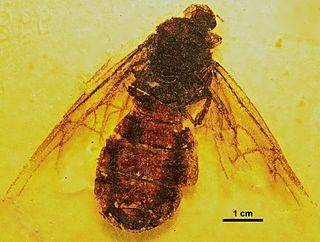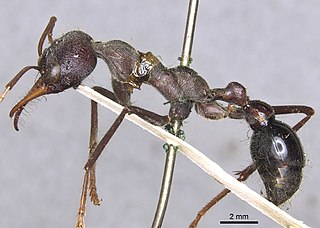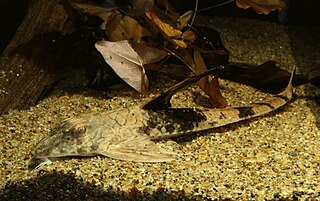Pyrgomantis simillima is a species of praying mantis found in Tanzania, Transvaal Province, and Zimbabwe. It was originally identified as two separate species: Pyrgomantis curta and Pyrgomantis simillima.
Cochlespira simillima is a species of sea snail, a marine gastropod mollusk in the family Cochlespiridae.

Pleurotomella simillima is a species of sea snail, a marine gastropod mollusk in the family Raphitomidae.

Titanomyrma is a genus of extinct giant ants which lived during the Eocene. The type species Titanomyrma gigantea and the smaller Titanomyrma simillima are known from the Eocene of Germany, while the third species Titanomyrma lubei, is known from Wyoming, United States. The presence of Titanomyrma in North America was considered to indicate "the first reported cross-Arctic dispersal by a thermophilic insect group".. However a queen reported from Upland temperate shales in British Columbia raised questions on the exact thermophilic nature of the genus. The type species of this genus, T. gigantea, is the largest-known fossil or extant species of ant in the world.
Aethalopteryx simillima is a moth in the family Cossidae. It is found in Somalia and Ethiopia.
Cymindis simillima is a species of ground beetle in the subfamily Harpalinae. It was described by Thomas Vernon Wollaston in 1865.
Amerila simillima is a moth of the subfamily Arctiinae. It was described by Walter Rothschild in 1917. It is found in Australia.
Damias simillima is a moth of the family Erebidae first described by Walter Rothschild in 1936. It is found in New Guinea.

Myrmecia simillima is an Australian ant which belongs to the genus Myrmecia. This species is native to Australia. Their distribution in Australia is massive on the coastline and inland areas of New South Wales and Victoria.
Schistophleps simillima is a moth in the subfamily Arctiinae. It was described by Rothschild in 1913. It is found in New Guinea.
Saphenista simillima is a species of moth of the family Tortricidae. It is found on Cuba.
Sychnovalva simillima is a species of moth of the family Tortricidae. It is found in Brazil in the states of Paraná, Santa Catarina and Minas Gerais.

Pterolophia is a genus of longhorn beetles of the subfamily Lamiinae, containing the following species:
Nordstromia simillima is a moth in the family Drepanidae. It was described by Frederic Moore in 1888. It is found in Kashmir in what was north-western British India.
Acalolepta simillima is a species of beetle in the family Cerambycidae. It was described by Stephan von Breuning and Ohbayashi in 1966. It is known from Japan.

Garymunida simillima is a species of squat lobster in the family Munididae. It occurs in French Polynesia. The specific name is derived from the Latin similis, which refers to its similarity to Agononida normani. The males measure from 12.4 to 13.5 millimetres and the females from 4.6 to 14.6 millimetres. It is found off of the Austral Islands, at depths between 200 and 1,000 metres.

Osmia simillima is a species of bee in the family Megachilidae. It is found in North America.
Lerista simillima, also known as the Fitzroy sandslider, is a species of skink. It is endemic to Western Australia. It is a fossorial species found in Acacia thickets and woodlands.

Loricaria simillima is a species of catfish in the family Loricariidae. It is native to South America, where it occurs in the basins of the Amazon River, the Orinoco, and the Río de la Plata in Argentina, Brazil, Ecuador, Paraguay, Peru, and Venezuela. The species reaches 26.4 cm in standard length and is believed to be a facultative air-breather.






